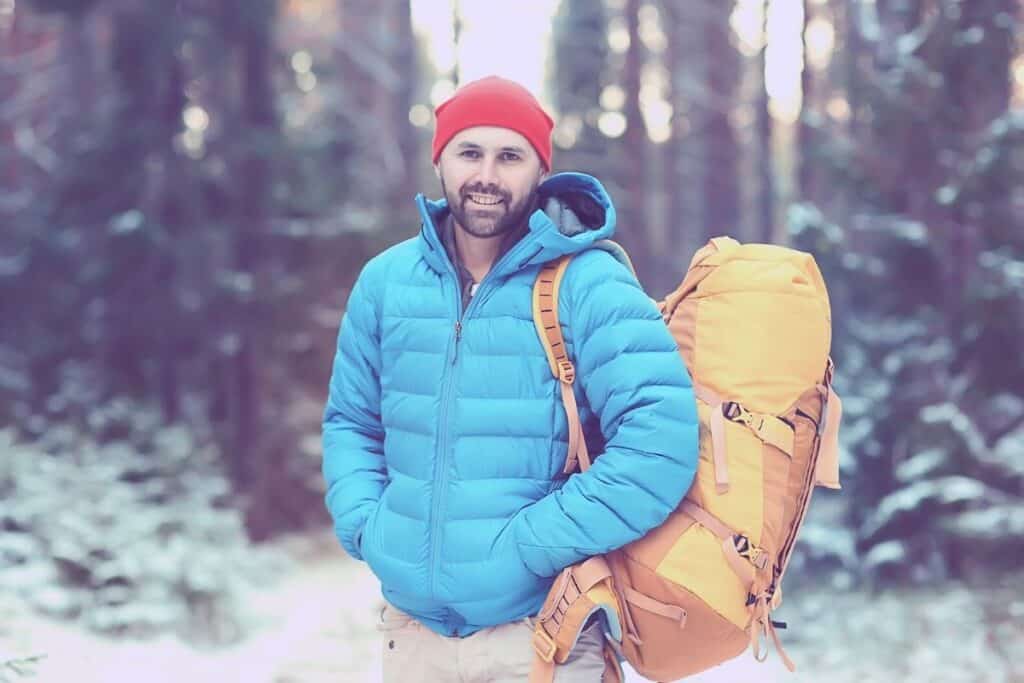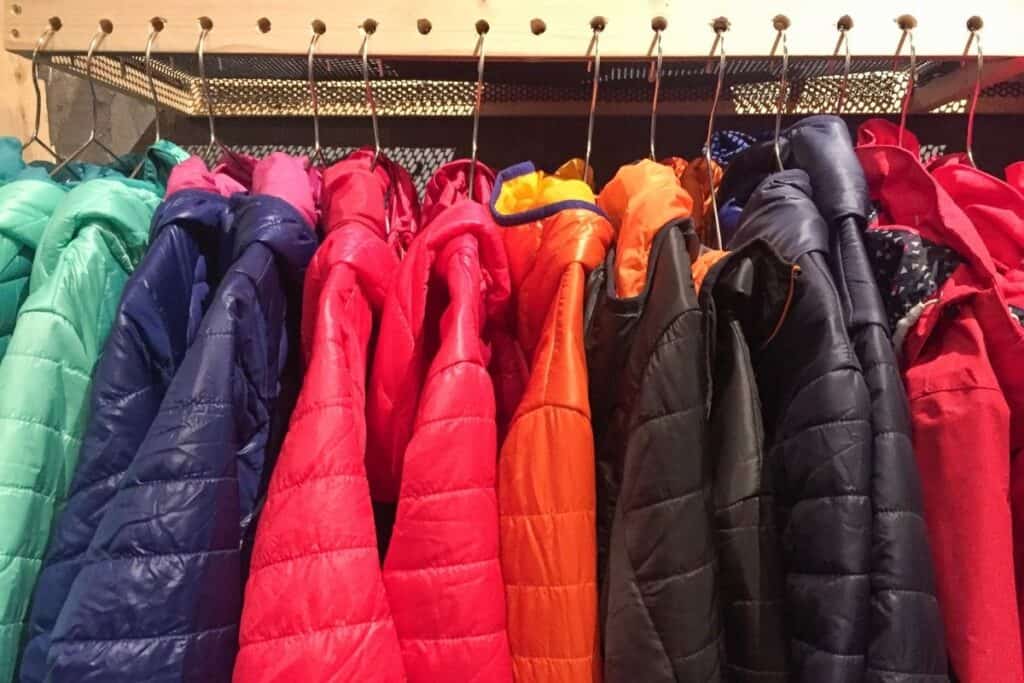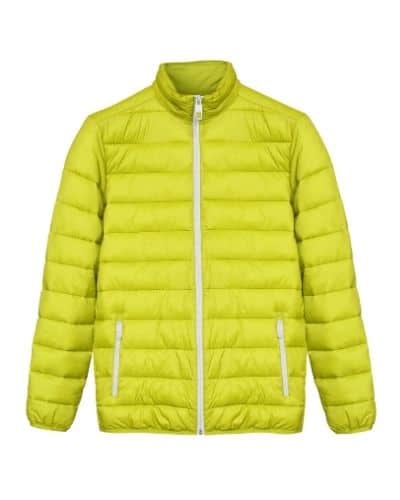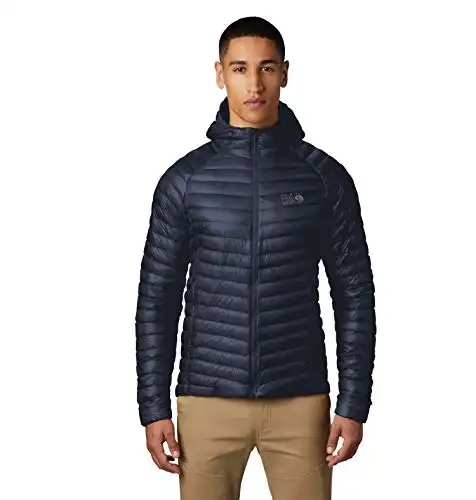
Down jackets are some of the warmest, lightest jackets on Earth. If you’re like me, once you get one that fits, you’ll never go back to traditional jackets again.
However, because they’re both expensive jackets and only perform at their best when properly fitted – you want to make sure that it fits just right to get the most out of your investment!
A properly sized down jacket should have a snug fit to prevent air from entering while also not restricting your movement in any way. It should also not feel tight across your chest, shoulders, or arms, nor should it expose your stomach when your arms are lifted overhead.
Knowing that a down jacket is not a cheap investment – let’s unpack that a bit further to help ensure that you buy the right jacket for you the first time!
Table of Contents
Down Jacket Fit Guide
Here we are at the fluffy core of our nicely insulated down jacket piece!
Before jumping in, it’s worth calling out that proper fit is vital because a down jacket that is too big or too small will result in less warmth for you. Essentially, you want there to be a small layer of air trapped between you and your jacket.
If this layer of air is too big, the cold will come in through your coattails. If there’s no layer of air, you’re missing out on valuable free insulation!

How To Know If Your Down Jacket Is Too Small
Your down jacket should feel comfortable when you’re wearing it. If it’s obviously difficult to put on, then you’ve got a jacket that’s too small.
When purchasing a down jacket, the first question is that of comfort. Your down jacket should feel good on you. It shouldn’t feel tight anywhere, in the shoulders, in the arms, or the chest.
If it is, try on the next size because your down jacket is too small!
Next, down jackets need to have utility. When trying on your down jacket, see if you can windmill your arms. If you can’t lift your arms directly above you, or if the seam of your jacket rides up and exposes your belly, your down jacket is too small.
Also, try the hug test. With the jacket on, try giving yourself a big arm-to-arm hug. Do it like you love yourself!
If you feel tightness across the shoulders when you do, say it with me, your down jacket is too small.
Finally, reach out in front of you. The arms of the jacket shouldn’t come up past your wrist.
How To Know If Your Down Jacket Is Too Big
Remember that your down jacket should have a solid layer of insulation in between you and the jacket; however, if that layer is too large, you’ll end up being colder.
The first test is all about its feeeellll.
If your jacket feels too big in any area – then it probably is too big!
If you’re not sure, look at the shoulder seams. The shoulder seams shouldn’t be sloping off at the sides; they should be directly on your shoulder and parallel to the ground. If they’re sloping off, your down jacket is likely too big.
Also, check out the sleeves. This can be the difference-maker for whether or not you’ve wasted your money. If the sleeves are too long, you’ll find wearing your down jacket more of a hassle than a sincere pleasure.
With your arms at your side, the sleeves should come past your wrist but not touch your knuckles. When you stretch them in front of you, your wrist should remain covered.
Selecting A Down Jacket
I’ve said it once, and I’ll say it a hundred times!
If you’re an outdoor enthusiast, buying a down jacket may be one of the smartest investments you can make!
Now, getting the fitting right on your down jacket is important, not just because you’ll be more comfortable with a better-fitting down.
If your down jacket is too big or too small, you just won’t be as warm!
However, in addition to the right fit, there are also other factors to consider when it comes to a great down jacket.
Two different types of down jackets contrast widely both in cost, comfort, and — significantly — warmth level.
The two types of down jackets are sewn-through and box baffle.

Sewn-Through
Sewn-through is usually significantly cheaper than box baffle, and that’s because the labor is considerably less to make the jacket. Besides, the sewn-through jackets are typically less warm than the box baffle jackets.
In a sewn-through jacket, the jacket is constructed by the traditional method: an inner lining is sewn in large swaths to an outer lining.
In between the inner and the outer linings, the down is stuffed into the jacket before being directly sewn into the lining, hence the category sewn-through.
I won’t get into the nitty-gritty here, but you should know that a sewn-through down jacket will almost always be less warm than its baffle box brethren.
Box Baffle
Box baffle is warmer, more expensive, and is typically the industry standard. In a box baffle jacket, small boxes are sewn into the jacket and stuffed with down.
This construction is a lot more expensive because it’s very time-consuming to make and sew in a multitude of little boxes and stuff them each with down. The returns are good, though, because box baffle jackets are extremely warm.
Just be careful when you’re buying a box baffle down: the smaller the boxes, the less warmth that the down will provide.
This is important if you’re new to down buying!
It’s become really trendy for box baffle jackets on the market to have extremely narrow boxes stuffed with down.
The smaller the box, the less the warmth, so be careful you’re not emptying your savings for a down that might look cool but won’t hold up in the heat (read: when it’s really, really cold).
How Warm Is My Down?
In addition to jacket construction, you’ll want to pay attention to the material your down jacket is made of, as well as its FDR (feather down rating, not Franklin Delano Roosevelt).
Duck, Duck, Goose
Down jackets are typically made from two very different birds: the duck and the goose.
Duck down jackets are typically cheaper and not as warm as goose down jackets.
This is because, according to J Kozák of the Asian-Australian Association of Animal Production Societies, “breeding geese by their brooding instinct develop denser down to keep the eggs warm.”
Watch for the material when selecting your down. You often won’t see a pure duck down jacket, so look for the percentage of down on the label. If you want the warmest jacket, you’ll want 100% goose down.
You know, now that I think of it, maybe that old nursery rhyme is really about selecting the warmest down jacket?
FDR (Feather Down Rating)
The second thing to be aware of in down selection is the FDR. We’re not going to get into it here in a big way because the science can be confusing and frankly, all we care about is getting you the right jacket!
Just know that the feather down rating is a measure of how warm your jacket will be. The FDR ranges from 400 to 900. If you’re doing outdoor rec in the winter, you generally don’t want less than 600, though if you’re living in, say, Prescott, AZ – that’s negotiable.
Typical down jackets range from 600 – 800 FDR.
The Pleasure Principle
So, you’ve got all the information you need for selecting the proper fitting down, but I wanted to emphasize one thing I touched on in this article.
A down jacket is extremely useful in cold conditions, but no matter what jacket you get or decide to purchase, the most important measure of its utility is your joy!
Down jackets have a really long-staying power, so these jacket-fitting guidelines are not must-abides; they’re simply suggestions to aid you in buying a down jacket that you’ll really cherish and, hopefully, keep for a long time.
In down jackets, I advise strict adherence to the pleasure principle: do all things with a view of your soul’s joy.
Recommended Down Jacket
While there are hundreds of down jackets to potentially choose from, I’d recommend starting your search with either of the two options shown below.
Not only are they fantastic products, but they’ll serve you well for many years to come!
This is the second iteration of the best-selling lightweight down jacket from Mountain Hardwear.
- A puffy jacket with 800-fill RDS-certified, breathable goose down
- 100% recycled, ultralight ripstop shell fabric with DWR finish
- Zippered hand pockets
- Elastic hood and cuffs; Hoodless version available
- Highly packable design stuffs into its own pocket with internal carabiner clip loop
The Illuminate Down Hoody and Jacket is a light, warm, and easy-to-grab midlayer pieces that pack that can into its own left-hand pocket!
- 800-fill responsibly sourced down jacket
- Sturdy100% nylon 10D shell and 20D lining
- Adjustable hood, zip chest media pocket, and elastic cuffs
- Internal Shove-It pockets are large enough for gloves and beanies
Never Be Down with the Right-Fitting Down!
Now that you know how to fit your down jacket properly, you should be totally down with down.
Down jackets are investments that will last you a long time and, because they can also be pretty pricey, deserve some serious consideration before purchase.
Think of how joyful it is to be warm and content before the fire on a snow-blanketed day in February. Then think of how great it is to be out in nature, in total solitude, or with your closest people, free of the fetters of this workaday world.
Well, put those two together, and that’s what owning a down jacket is like. In any case, I think it’s a good idea, and as you can tell, I’m totally biased.
Whatever you decide, my friends, go forth, reach new heights, and always remember this advice an old hiker once gave me when I was backpacking the AT: you’ll never see the end of the trail if you don’t take the first step.
Related Articles
If you found this article helpful, then make sure to also take a look at my other related articles!



